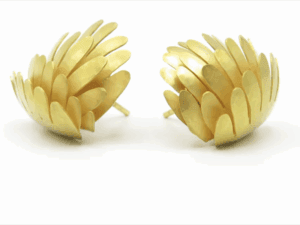crafthaus is an online community with close to 2000 members. Brigitte Martin, who is the originator of crafthaus and keeps all their balls in the air, is also a gallery member of AJF. crafthaus is a place for professional craft artists to display their work and connect internationally across all fields of interest. Each month, one of the members is asked to curate an online exhibition. During the month of March, Spanish jeweler Montserrat Lacomba was asked to do the honors. Her exhibition focuses on the Massana School of Barcelona where she studied.
Susan Cummins: How long will this exhibit be available online?
Montserrat Lacomba: All crafthaus online exhibitions are headline news for a full month. My exhibition was originally featured from February 24 to March 24, 2012. However, all past crafthaus exhibitions remain on the website indefinitely, so now you can find my exhibit listed under the Past Exhibition tab on the home page.
What is your background?
I am a jewelry maker living and creating in Girona (near Barcelona) and Formentera (Balearic Islands) in Spain. I earned a BFA (1982) and I studied at the Massana School from 2003 to 2005 with Silvia Walz. I am interested in contemporary art jewelry and in sharing information about this art form, that’s why in 2008 I created the blog Mar de Color Rosa,where I post jewelry news, jewelry exhibitions and information about jewelry artist daily. I joined crafthaus in 2009 and since then have learned a lot and connected with many people interested in jewelry worldwide.
How did you come to curate an online exhibition for crafthaus?
Brigitte Martin, the crafthaus editor, approached me about a year ago asking if I was interested to curate an exhibition of Spanish art jewelry specifically. She felt that there was not enough exposure in the United States of the kind of work we do in Spain and she thought it would be interesting for the crafthaus community to learn more about it. Naturally, I loved that idea and jumped right on it.
How do you feel about online exhibitions?
I love them. I have seen a great deal of interesting work in online exhibitions that I otherwise would not have had a chance to see. As much as I would want to travel the globe, I can’t. Online exhibitions bring the world to me.
Why did you choose to show the work of the students at the Massana School in Barcelona?
The Massana School is the heart of the contemporary jewelry world in Spain. Because I was a student at Massana myself, naturally I have strong feelings for the school, the professors and the students that are currently studying there. It was a natural choice for me to highlight their history and their work.
How did you decide what pieces to put in the show? Does it include students and teachers?
Silvia Walz and her husband Ramon Puig Cuyàs, who is head of the Jewelry Department at Massana, helped me formulate the general idea for the exhibit. The initial thought Brigitte and I had was to have two separate shows, one for the teachers and one for the students and to show multiple pieces by each artist. However, after looking at the great number of images we ended up having at our disposal and the task of bringing these images into a cohesive online exhibition format, Brigitte and I decided to exhibit just one signature piece from each artist rather than multiple pieces. I think that was a good decision as it helped to focus the show while maintaining the overview we intended to give.
How do you define contemporary jewelry? Can you pick out some of your favorite pieces and talk about how they illustrate this definition?
For me, contemporary jewelry is the creation of objects with an underlying theoretical approach. Contemporary art jewelry pieces are wearable art objects.
More than placing emphasis on one jewelry piece in particular, I prefer to take reference from an artist’s overall trajectory of work and the background and history from which the work stems. I admire Ramon Puig Cuyàs for his career and because he managed to introduce contemporary jewelry as a separate art form in Spain. I am also a fan of my former professor Silvia Walz who looks for new ways to express herself with each new series she investigates, new materials she chooses and new techniques she explores. That makes her work interesting to me.
Another artist I like is Myung Urso. She manages to create a dialogue in her jewelry between the past and the present. I also enjoy Märta Mattsson’s work, which evokes a strong reaction in the viewer due to its tension between attraction and repulsion. Overall, I am mostly drawn to jewelry that is able to move my emotions.
What do you think art jewelry will look like in the future?
I think that is hard to say. There are always new techniques and material combinations popping up, someone somewhere will think of something new to explore. Jewelry tends to respond to contemporary issues of its time, like many other art forms as well. Whatever the future may hold, I am sure art jewelry will continue to change in material and form and thereby expand its vocabulary.





